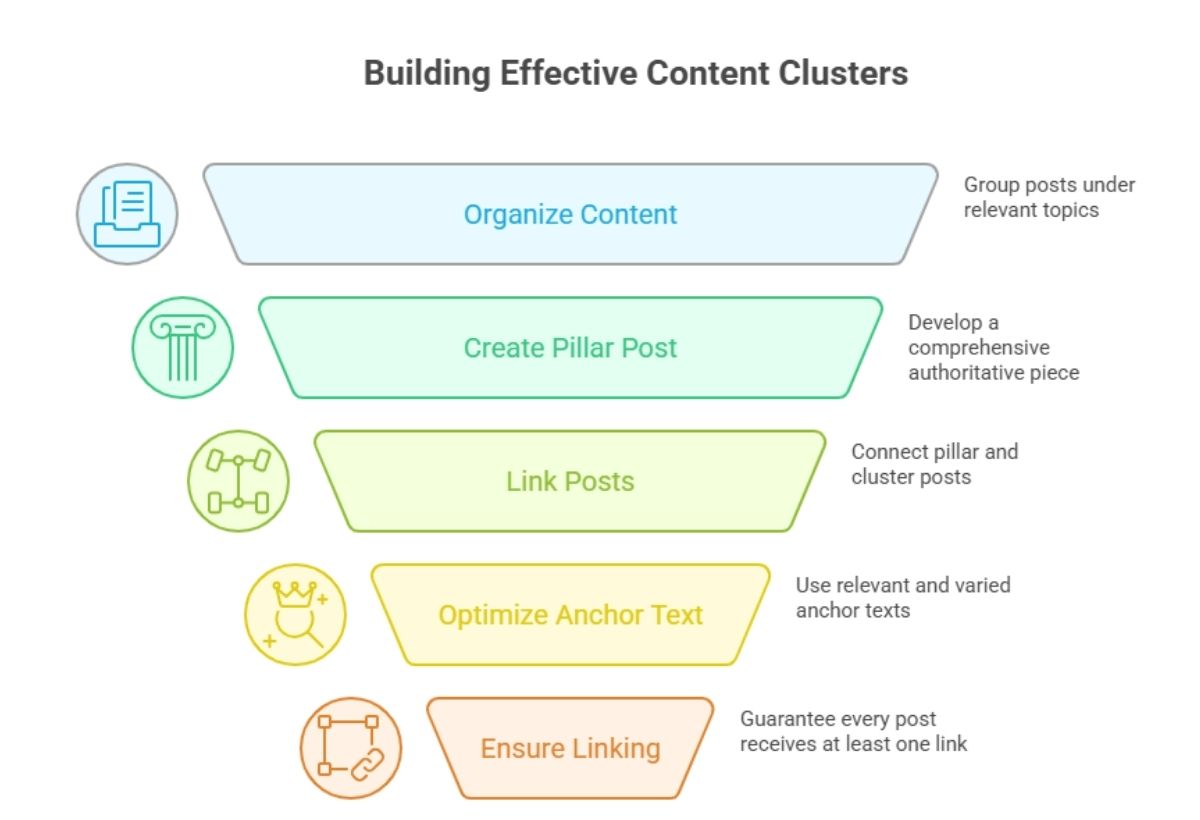When it comes to boosting your website’s SEO performance, few strategies are as effective yet underutilized as proper internal linking within content clusters. This powerful approach helps search engines understand your site structure, establishes topical authority, and guides users through related content. But there’s a right way and a wrong way to implement this strategy. Let’s dive into the proven techniques that will transform your site’s architecture and boost your rankings.
Build internal links within a content cluster
Content clusters aren’t just a trendy SEO concept – they’re the backbone of modern content organization. When done right, they create a web of related information that search engines love.
Group related posts by core topic
The first step in building effective content clusters is identifying your main topics or themes. Look at your content and ask: “What are the primary subjects we cover?” For example, if you run a digital marketing blog, your core topics might include SEO, social media, email marketing, and content strategy.
Once you’ve identified these themes, organize your existing content under these umbrellas. This creates natural groupings that make internal linking more intuitive. Use a spreadsheet to map out these relationships if you have a large content library – this visual organization makes the next steps much easier.
Link supporting posts to the pillar post
Every content cluster needs a “pillar” – a comprehensive, authoritative piece that covers the broader topic in depth. This pillar post should link out to more specific “cluster” posts that explore individual aspects of the topic in greater detail.
For example, if “Content Marketing Strategy” is your pillar post, it might link to cluster content like “Creating a Content Calendar,” “Content Distribution Channels,” and “Content ROI Measurement.”
Just as important: make sure each cluster post links back to the pillar. This creates a hub-and-spoke model that clearly signals to search engines which content pieces are related and which page is the primary authority on the topic.
Keep anchor texts relevant and varied
When linking between cluster content, your anchor text (the clickable words that contain the link) matters tremendously. Avoid generic phrases like “click here” or “learn more” – these waste valuable SEO opportunities.
Instead, use descriptive anchor text that includes relevant keywords or phrases that accurately describe the destination page. But don’t use identical anchor text for every link to the same page! Mix it up with variations to create a natural link profile.
-
Poor anchor text: “Click here to learn more about content clusters.”
-
Better anchor text: “Our guide to building effective content clusters explains this concept in detail.”
Ensure every post receives at least one link
No piece of content should exist in isolation. The “orphaned content” problem (pages with no internal links pointing to them) can seriously hamper your SEO efforts. Search engines might not discover these pages, and even if they do, they’ll assign them less importance.
Make it a rule that every new piece of content should receive at least one internal link from an existing, relevant page. For older content, conduct regular audits to identify and fix orphaned pages by adding appropriate internal links from related content.
Use consistent URL structures and taxonomy
The way you organize your content at the technical level reinforces the relationships you’re building with internal links. A logical site structure helps both users and search engines navigate your content ecosystem.
Create logical category and folder structure
Your URL structure should reflect your content organization. Create a hierarchy that makes sense for your specific topics and subtopics. For example:
-
/content-marketing/ (main category)
-
/content-marketing/strategy/ (subcategory)
-
/content-marketing/strategy/b2b-content-plan/ (specific article)
This clear structure instantly communicates relationships between content pieces. It also makes it easier to implement breadcrumbs, which provide additional internal linking opportunities and improve user navigation.
Match internal links with topic hierarchy
Your internal linking should follow the same logical hierarchy as your URL structure. Pages higher in the hierarchy (like category pages) should link to more specific pages below them, while specific pages should link back up to their parent categories.
This approach creates a natural flow of link equity (SEO value) throughout your site, ensuring that important pages receive the visibility they deserve while supporting pages get discovered through contextual relationships.
Avoid mixing themes within a content cluster
While it might be tempting to add links between loosely related topics, resist this urge when building content clusters. Keep your clusters focused on tightly related themes.
If a post about “Email Marketing Automation” starts linking to “Social Media Analytics,” you’re diluting the topical focus of your cluster. Save cross-cluster linking for truly relevant connections, and prioritize strengthening the relationships within each individual cluster first.
Optimize anchor text for target keywords
Anchor text optimization remains one of the most powerful aspects of internal linking strategy. The words you choose tell both users and search engines what to expect on the destination page.
Stick to natural language and context
Gone are the days when keyword-stuffed anchor text helped rankings. Today, natural language that flows within the context of your content performs best. Your internal links should feel like helpful resources for readers, not obvious SEO manipulation.
The surrounding text matters too. Introduce links within relevant discussions where they add value to the reader. A well-placed link within a paragraph explaining a concept will get more engagement than a random link tacked on as an afterthought.
Use variety to avoid keyword stuffing
If you link to your “Content Strategy Guide” from 20 different pages using identical anchor text, it looks manipulative. Instead, use a range of natural variations:
-
“comprehensive content strategy guide”
-
“planning your content strategy”
-
“strategic content planning approach”
-
“content strategy fundamentals”
This variety creates a more natural link profile while still reinforcing your target keywords and topics.
Add modifiers for long-tail keyword targeting
Expand your keyword reach by incorporating modifiers into your anchor text. Instead of just “content clusters,” use expanded phrases like “building effective content clusters,” “content clusters for e-commerce,” or “how content clusters improve SEO.”
These long-tail variations help you rank for a broader range of search queries while still reinforcing your core topics. They also create more specific expectations for users, potentially improving click-through rates on your internal links.
Strengthen SEO with smart content linking
Implementing a strategic internal linking approach within content clusters isn’t just good practice – it’s essential for modern SEO success. By organizing related content, creating logical hierarchies, and optimizing your anchor text, you build a site structure that both users and search engines can easily navigate and understand.
Remember that internal linking isn’t a “set it and forget it” task. As you publish new content, look for opportunities to connect it with existing pages. And regularly audit your site to identify weak spots in your internal linking structure. This ongoing maintenance ensures your content clusters continue to deliver SEO value over time.
FAQs
How do internal linking strategies improve SEO?
Internal linking improves SEO in multiple ways: it helps search engines discover and index your content, distributes page authority throughout your site, establishes topical relevance and expertise, reduces bounce rates, and increases time on site. When organized in content clusters, these links signal to search engines that you have comprehensive coverage of specific topics, potentially boosting your rankings for related keywords.
What’s the best way to define a content cluster for blogs?
Start by identifying a core topic that’s relevant to your audience and business goals. This becomes your pillar content. Then brainstorm related subtopics that address specific aspects, questions, or applications of the main topic. These become your cluster content. The key is ensuring there’s a clear thematic relationship between all pieces in the cluster, with the pillar content providing the comprehensive overview that ties everything together.
Can too many internal links hurt SEO performance?
Yes, excessive internal linking can dilute the value of your links and make pages look spammy to both users and search engines. While there’s no magic number, focus on quality over quantity. Each internal link should serve a purpose and provide value to readers. A good rule of thumb is to include 3-5 relevant internal links per 1,000 words of content, though this can vary based on your specific content type and structure.
How does anchor text relevance affect Google rankings?
Anchor text helps Google understand what the destination page is about and which keywords it might be relevant for. Using descriptive, keyword-rich (but natural) anchor text can positively impact rankings for those terms. However, over-optimization with too many identical anchor texts can trigger spam filters. The best approach is using varied, contextually relevant anchor text that accurately describes the linked page’s content.
How often should I review and update internal links?
Conduct a comprehensive internal link audit at least quarterly for active sites. This includes checking for broken links, identifying opportunities for new connections as content expands, and ensuring your anchor text strategy remains consistent. Additionally, whenever you publish new cornerstone content or substantially update existing pillar pages, review related cluster content to update internal links accordingly.

Ridam Khare is an SEO strategist with 7+ years of experience specializing in AI-driven content creation. He helps businesses scale high-quality blogs that rank, engage, and convert.




